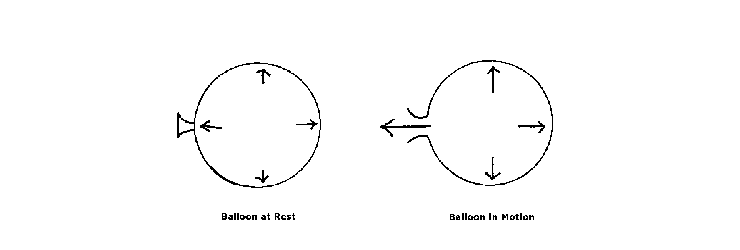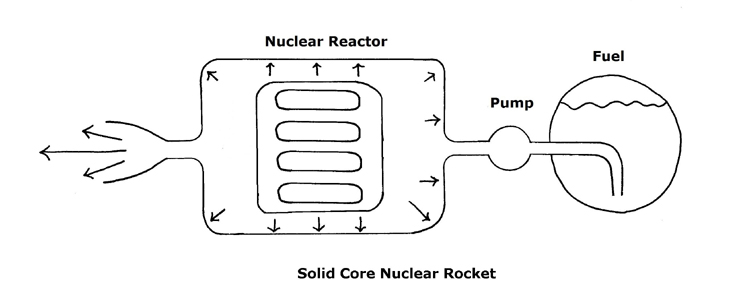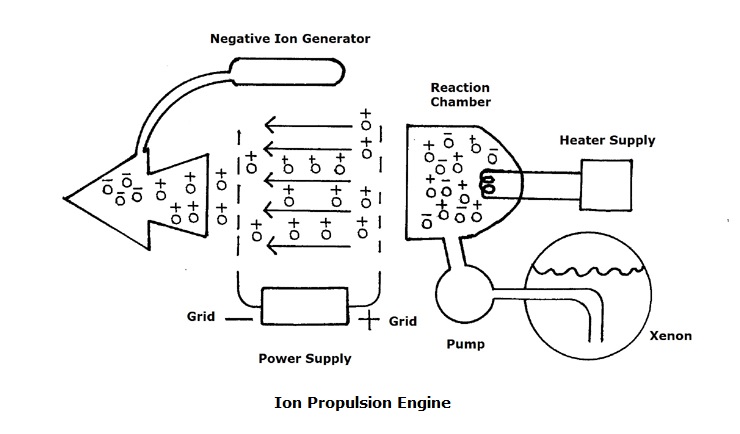|
|
|
|
||||||||||
|
||||||||||||
 |
||||||||||||
|
|
|
 |
|
Spaceship Rocket Primer |
|
So you need to transport your hero and his companions to the Moon. What do you use to get him/them there? You could use vials of morning dew. or a flock of large birds harnessed to the space vehicle. Don’t laugh; both have been used in literature. What about a substance that neutralizes gravity or a giant cannon? Close but no cigar. Cavorite doesn’t exist, unfortunately. The giant cannon sounds promising, but there are problems with that too – like the extreme acceleration and the resistance of the atmosphere. But you’re way ahead of me. “A rocket,” you exclaim. “I’ll use a rocket!” A reaction engine. You’ll use a reaction engine, a device that uses Newton’s Third Law of Motion: For every action, there is an equal but opposite reaction, hence the name. Essentially, if you propel mass out one end of the reaction engine, you generate an equal force (thrust) on the other end. Imagine a blown-up balloon. The force of the compressed air is exerted in all directions equally; therefore, the balloon is motionless. Open a hole in the balloon at some point, and the air rushes out at that point. The air pressure at the opposite end of the balloon is no longer balanced, producing a net force in that direction. The balloon rushes off in that direction -- rapidly. Note that the force is internal to the balloon. The escaping air doesn’t “push” on anything to produce thrust. In fact, the reaction engine functions most efficiently in space where air resistance is absent.
Of course, a compressed gas reaction engine is not very useful. We need something more energetic. What if we were to burn something inside a reaction chamber? Now we have hot gas coming out the end of the reaction engine to generate the thrust. In the atmosphere, we could use air to burn the fuel, then we have a jet engine, but if we want to travel in space, we need to carry our own air – or oxidizer.—with us. We need both fuel and oxidizer to make the rocket work. How we do that determines what kind of reaction engine we use. We have quite a few types of reaction engine to choose from: solid fuel, liquid fuel, hybrid, nuclear, and ion propulsion. We will examine each in turn and discuss their advantages and disadvantages. Solid Fuel Rocket Solid fuel rockets were invented first and are still in use today in everything from fireworks to the largest modern boosters. In this case, both the fuel and oxidizer are solid and mixed together in the proper proportions during manufacture. Early examples had a problem: they had a limited shelf life. After prolonged storage they tended to develop cracks in the black powder propellant, producing accelerated burning and subsequent explosion of the casing. Modern solid fuel rockets no longer use black powder as the propellant and have virtually unlimited shelf life. Another advantage is there is no limit to the size – and thrust--of a solid fuel rocket. The disadvantage is that once you ignite it, you cannot stop it. It burns until all the propellant is exhausted. Careful design can change the amount of thrust with time. For example, you could have maximum thrust at the beginning of the burn and less thrust later. More often, however, the thrust increases with time until burnout. Once the solid fuel booster exhausts its propellant, it is no longer needed and is discarded.
Liquid Fuel Rocket Liquid fuel rockets were developed to overcome the disadvantages of solid fuel rockets. Well-designed liquid fuel rockets can be stopped and restarted, can be throttled and can be built as large as desired, although very large liquid fuel rockets have instability problems that must be overcome. Liquid fuel rockets propel everything from rocket airplanes to rockets to the moon. Thrust is only limited by the size of the rocket and duration is only limited by the amount of propellant that can be carried aboard the vehicle. Liquid fuel rockets are complicated to engineer, generally requiring at least two tanks (fuel and oxidizer), pipes, pumps or pressurization and control equipment. Liquid fuel rockets form the basis for all modern space vehicles, and will be with us for a long time to come.
Hybrid Fuel Rocket Hybrid rockets are a combination of solid and liquid fuel rockets, combining the stability and simplicity of solid fuel rockets with the versatility of liquid fuel rockets. Hybrid rocket engines are used in present-day private spacecraft, such as Space Ship One. The fuel for combustion is solid; the oxidizer is liquid or gaseous. Varying the amount of oxidizer varies the thrust. Cutting it off entirely stops the engine. Small hybrid engines are being used today, but more development is necessary to make them safe and reliable.
Nuclear Rocket Once a promising technology, nuclear rockets are less popular today, mostly for environmental reasons. Advantages are efficiency, simplicity and scalability. Disadvantage is intense radiation, both from the reactor and the exhaust. A manned vehicle requires shielding to protect the crew. Nuclear rockets are simple, in principle. A liquid is circulated through a nuclear reactor, absorbing the heat and turning it into a gas under great pressure, propelling the spacecraft. Nuclear rockets are classified according to the type of reactor core involved. Solid core rockets use a solid nuclear reactor. The advantage is simplicity. Performance is limited by the melting points of the materials in the reactor. Liquid and gas core reactors can operate at much higher temperatures, producing much better performance, but are much more complicated to design and build. The main problem is retaining the fissionable materials inside the engine while it is running. Another type is called nuclear pulse propulsion. In this case, small atomic bombs are ejected from the base of the spacecraft and detonated, propelling it forward. This rocket is incredibly inefficient, but was once seriously considered for a spaceship designed to go to Mars. Type “Project Orion” into your favorite search engine for more information.
Ion Propulsion A variation of the nuclear rocket, ion propulsion has been used with spectacular results in actual spacecraft. Its advantage is high efficiency; its disadvantage is low thrust. Essentially, an electrically neutral fluid, usually xenon gas, is heated to a high temperature to form ions, which are accelerated using a powerful electrical field generated using solar power or a nuclear reactor to produce thrust. Over long periods of time, this type of rocket can produce high velocities.
Solar Sail The solar sail is a promising technology that has yet to be developed to its full potential. Essentially it is what the name suggests – a sail that uses solar radiation to produce thrust, much as a terrestrial sail uses the wind to provide propulsion for a ship. The solar sail concept has been successfully tested in near-Earth space. Further advances in technology are needed to make it practical. Other technologies include ground-based lasers, fusion-powered rockets and concepts limited only by your imagination. |
|
[Index] [About Us] [Stories] [Guest Art] [Guest Art Page] [Editors Write] [Archives] [Contact Us] [Links] |






